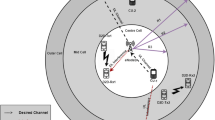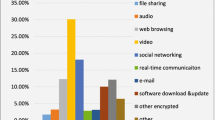Abstract
Multiple communication applications such as high-quality video streaming, IoT, cellular vehicle to anything, augmented reality, virtual reality, and low-latency web browsing make the cellular network heterogeneous. To seamlessly support heterogeneous functionality in the upcoming 6G mobile network, the open radio access network (O-RAN) Alliance is being formed. The O-RAN Alliance is a step towards defining a standard interface between systems. It aims to reduce complexity and accelerate the deployment of 6G mobile networks. However, in deploying the 6G mobile network, the efficient sharing of resources among heterogeneous users is challenging. We considered a novel ultra-dense heterogeneous 6G O-RAN-based cellular network architecture and proposed a multi-objective particle swarm optimization at both small cell base stations (SBSs) and macrocell base stations (MBSs) for collaborative resource optimization. Analytical expressions are derived for joint energy and spectrum optimization at SBS and MBS. The simulation results show that the proposed scheme has a noticeable effect on the optimization of the energy consumption of the system in different scenarios and prove that this algorithm has a remarkable convergence.








Similar content being viewed by others
Data Availibility
This manuscript has no associated data.
Code Availability
This manuscript has no associated code.
References
Chowdhury, M. Z., Shahjalal, M., Ahmed, S., & Jang, Y. M. (2020). 6G wireless communication systems: Applications, requirements, technologies, challenges, and research directions. IEEE Open Journal of the Communications Society, 1, 957–975. https://doi.org/10.1109/OJCOMS.2020.3010270
Mushtaq, M. S., Mellouk, A., Augustin, B., & Fowler, S. (2016). QoE power-efficient multimedia delivery method for LTE-A. IEEE Systems Journal, 10(2), 749–760. https://doi.org/10.1109/JSYST.2015.2435994
Jiang, W., Han, B., Habibi, M. A., & Schotten, H. D. (2021). The road towards 6G: A comprehensive survey. IEEE Open Journal of the Communications Society, 2, 334–366.
Talwar, S., Himayat, N., Nikopour, H., Xue, F., Wu, G., & Ilderem, V. (2021). 6G: Connectivity in the era of distributed intelligence. IEEE Communications Magazine, 59(11), 45–50. https://doi.org/10.1109/MCOM.011.2100162
Li, B., Hou, P., Wu, H., & Hou, F. (2021). Optimal edge server deployment and allocation strategy in 5G ultra-dense networking environments. Pervasive and Mobile Computing, 72, 101312.
Kumar, A., Suman, S. K., Bhagyalakshmi, L., & Sahu, A. K. (2022). Iot and cloud network based water quality monitoring system using IFTTT framework, pp. 23–32.
Weiss, M. B. H., Werbach, K., Sicker, D. C., & Bastidas, C. E. C. (2019). On the application of blockchains to spectrum management. IEEE Transactions on Cognitive Communications and Networking, 5(2), 193–205. https://doi.org/10.1109/TCCN.2019.2914052
Hsu, C.-H., Manogaran, G., Srivastava, G., & Chilamkurti, N. (2021). Guest editorial: 6G-enabled network in box (NIB) for industrial applications and services. IEEE Transactions on Industrial Informatics, 17(10), 7141–7144. https://doi.org/10.1109/TII.2021.3067707
Ziegler, V., & Yrjölä, S. (2021). How to make 6G a general purpose technology: Prerequisites and value creation paradigm shift, 586–591 https://doi.org/10.1109/EuCNC/6GSummit51104.2021.9482431.
Elsayed, M., & Erol-Kantarci, M. (2019). AI-enabled future wireless networks: Challenges, opportunities, and open issues. IEEE Vehicular Technology Magazine, 14(3), 70–77.
Zhang, H., Zhou, H., Erol-Kantarci, M. (2022). Team learning-based resource allocation for open radio access network (O-RAN), ar**v preprint ar**v:2201.07385.
Israr, A., Yang, Q., & Israr, A. (2022). Power consumption analysis of access network in 5G mobile communication infrastructures-an analytical quantification model. Pervasive and Mobile Computing, 80, 101544.
Alsabah, M., Naser, M. A., Mahmmod, B. M., Abdulhussain, S. H., Eissa, M. R., Al-Baidhani, A., Noordin, N. K., Sait, S. M., Al-Utaibi, K. A., & Hashim, F. (2021). 6G wireless communications networks: A comprehensive survey. IEEE Access, 9, 148191–148243. https://doi.org/10.1109/ACCESS.2021.3124812
Cicconetti, C., de la Oliva, A., & Pompili, D. (2022). Special issue on edge computing in pervasive systems. Pervasive and Mobile Computing, 83, 101617.
Rappaport, T. S., **ng, Y., Kanhere, O., Ju, S., Madanayake, A., Mandal, S., Alkhateeb, A., & Trichopoulos, G. C. (2019). Wireless communications and applications above 100 GHz: opportunities and challenges for 6G and beyond. IEEE Access, 7, 78729–78757.
Latif, S., et al. (2022). An efficient pareto optimal resource allocation scheme in cognitive radio-based internet of things networks. Sensors (Basel). https://doi.org/10.3390/s22020451
Niknam, S., Roy, A., Dhillon, H. S., Singh, S., Banerji, R., Reed, J. H., Saxena, N., & Yoon, S. (2020). Intelligent O-RAN for beyond 5G and 6G wireless networks. ar**v preprint ar**v:2005.08374
Zong, B., Fan, C., Wang, X., Duan, X., Wang, B., & Wang, J. (2019). 6G technologies: Key drivers, core requirements, system architectures, and enabling technologies. IEEE Vehicular Technology Magazine, 14(3), 18–27.
Saad, W., Bennis, M., & Chen, M. (2019). A vision of 6G wireless systems: Applications, trends, technologies, and open research problems. IEEE Network, 34(3), 134–142.
Ravindran, S., Chaudhuri, S., Bapat, J., & Das, D. (2021). Optimization results for 5G slice-in-slice scheduling. ar**v preprint ar**v:2106.14426
Viswanathan, H., & Morgensen, P. E. (2020). Communications in the 6G era. IEEE Access, 8, 57063–74.
Motalleb, M. K., Shah-Mansouri, V., & Naghadeh, S. N. (2019). Joint power allocation and network slicing in an open ran system. ar**v preprint ar**v:1911.01904
Pamuklu, T., Mollahasani, S., & Erol-Kantarci, M. (2021). Energy-efficient and delay-guaranteed joint resource allocation and DU selection in O-RAN. In 2021 IEEE 4th 5G world forum (5GWF), IEEE, pp. 99–104.
Olwal, T. O., Djouani, K., & Kurien, A. M. (2016). A survey of resource management toward 5G radio access networks. IEEE Communications Surveys Tutorials, 18(3), 1656–1686. https://doi.org/10.1109/COMST.2016.2550765
Kumar, V., & Minz, S. (2014). Multi-objective particle swarm optimization: An introduction. SmartCR, 4(5), 335–353.
Kim, H., & Clayton, M. J. (2020). A multi-objective optimization approach for climate-adaptive building envelope design using parametric behavior maps. Building and Environment, 185, 107292.
Liang, L., Kim, J., Jha, S. C., Sivanesan, K., & Li, G. Y. (2017). Spectrum and power allocation for vehicular communications with delayed CSI feedback. IEEE Wireless Communications Letters, 6(4), 458–461.
Funding
Funding information is not applicable/no funding is received.
Author information
Authors and Affiliations
Contributions
All authors contributed to the study conception and design. Material preparation, data collection, and analysis were performed by Gopal Chandra Das and Seemanti Saha.
Corresponding author
Ethics declarations
Conflict of interest
The authors have no Conflict of interest to declare. All co-authors have seen and agree with the contents of the manuscript and there is no financial interest to report. We certify that the submission is original work and is not under review at any other publication.
Additional information
Publisher's Note
Springer Nature remains neutral with regard to jurisdictional claims in published maps and institutional affiliations.
Rights and permissions
Springer Nature or its licensor (e.g. a society or other partner) holds exclusive rights to this article under a publishing agreement with the author(s) or other rightsholder(s); author self-archiving of the accepted manuscript version of this article is solely governed by the terms of such publishing agreement and applicable law.
About this article
Cite this article
Das, G.C., Saha, S. Joint Energy and Spectrum Resource Optimization in 6G Ultra-Dense O-RAN Heterogeneous Network Under Rayleigh Fading. Wireless Pers Commun 136, 1517–1530 (2024). https://doi.org/10.1007/s11277-024-11314-w
Accepted:
Published:
Issue Date:
DOI: https://doi.org/10.1007/s11277-024-11314-w




